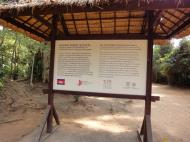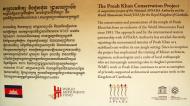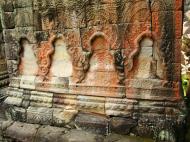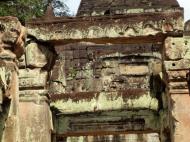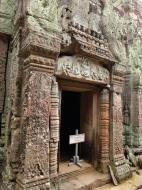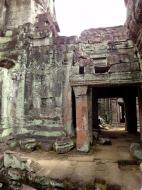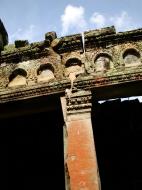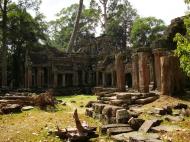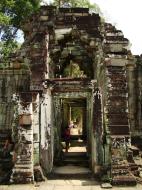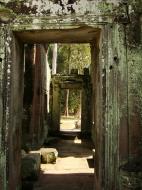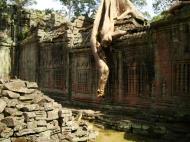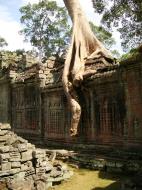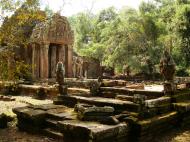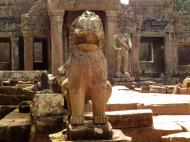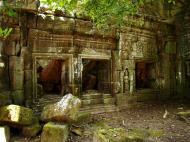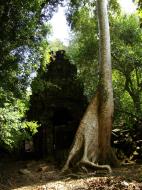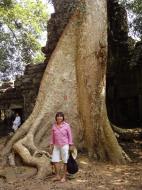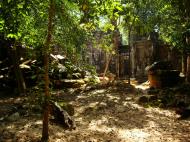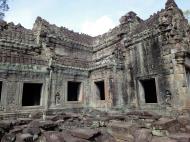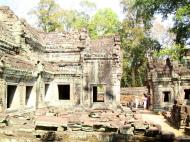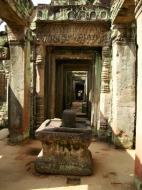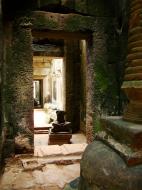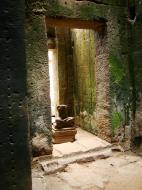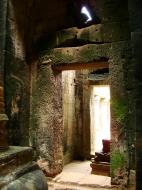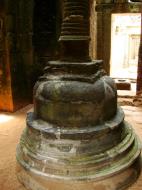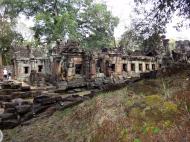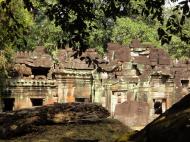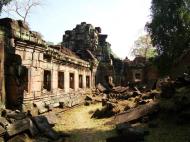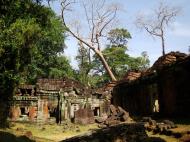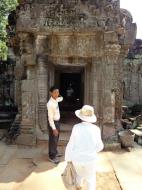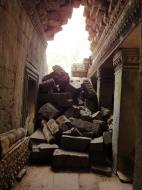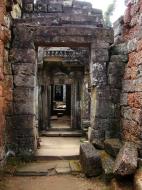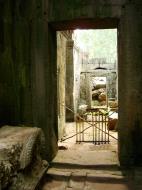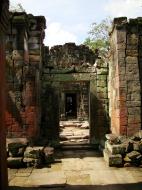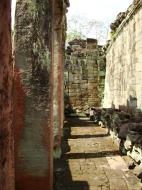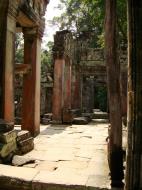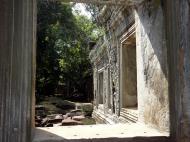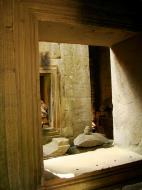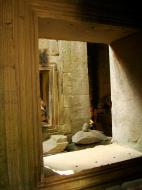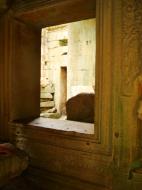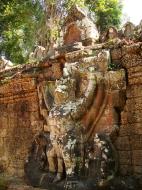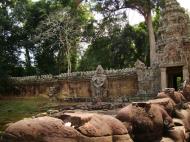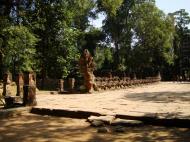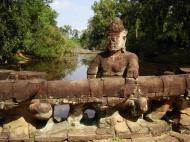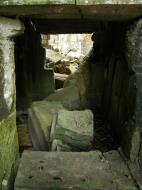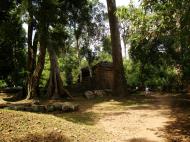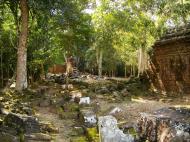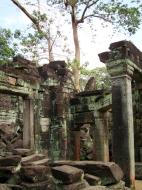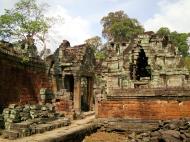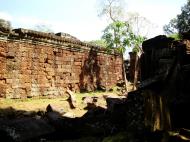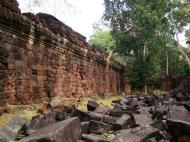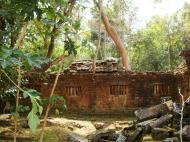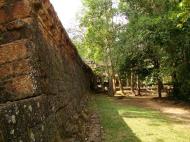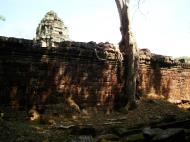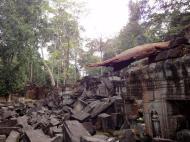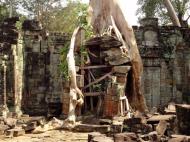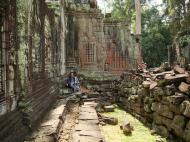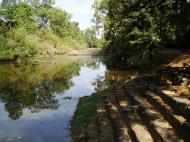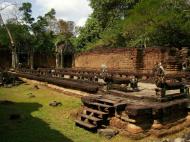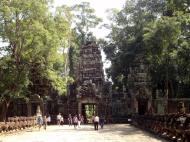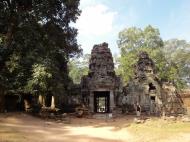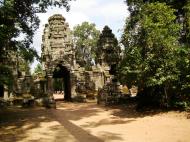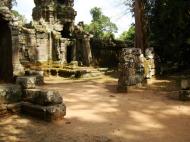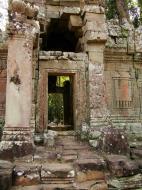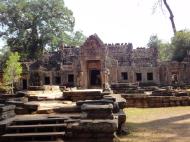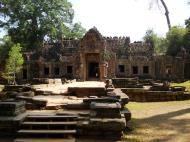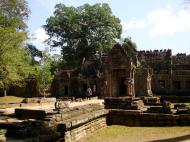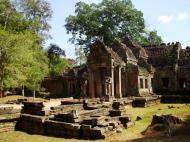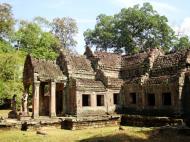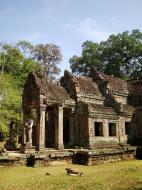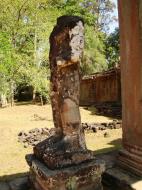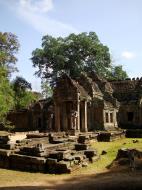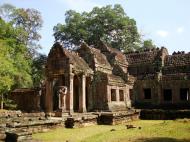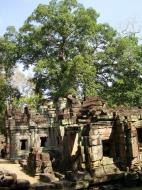Preah Khan Temple or Prah Khan Temple
Name: Preah Khan
Creator: Jayavarman VII
Date built: 1191 A.D.
Primary deity: Avalokiteshvara
Architecture: Khmer
Location: Angkor, Cambodia
Coordinates: 13.4619594°N 103.8715911°EIt stands as the largest single religious complex ever built during Angkorian Era, even if its isolated location makes it one of less visited angkorian sites. Preah Khan sometime transliterated as Prah Khan, is a temple at Angkor, Cambodia, built in the 12th century for King Jayavarman VII. It was the centre of a substantial organisation, with almost 100,000 officials and servants. The temple is flat in design, with a basic plan of successive rectangular galleries around a Buddhist sanctuary complicated by Hindu satellite temples and numerous later additions. Like the nearby Ta Prohm, Preah Khan has been left largely unrestored, with numerous trees and other vegetation growing among the ruins.
World Heritage Status
This site was added to the UNESCO World Heritage Tentative List on September 1st, 1992 in the Cultural category.
Situé à l'est d'Angkor, le Prah Khan de Kompong Svay a la particularité de ne pas etre orienté Est-Ouest mais d'etre desaxé vers le Nord. Les monuments de la première enceinte sont le sanctuaire principal, la bibliothèque Sud, la bibliothèque Nord et une galerie d'enceinte avec ses gopura. Les monuments de la seconde enceinte se repartssent en galerie d'enceinte avec ses gopura, un groupe de quatre sanctuaires à l'Est, trois tours sur l'axe des Gopura Est, Nord et Sud, une terrasse des bassins et d'autres édifices annexes. Les monuments de la troisieme enceinte sont le gite d'etape, l'abris de l'inscription, l'enceinte proprement dite ainsi que les gopura et les douves.
History
It was a royal residence during the kingdom of Suryavarman II and even Jayavarman VII lived before recapturing the capital city of Yasodharapura from invading Chams in 1181.
Preah Khan was built on the site of Jayavarman VII's victory over the invading Chams in 1191.
Unusually the modern name, meaning "holy sword", is derived from the meaning of the original - Nagara Jayasri (holy city of victory). The site may previously have been occupied by the royal palaces of Yasovarman II and Tribhuvanadityavarman.
The temple's foundation stela has provided considerable information about the history and administration of the site: the main image, of the boddhisatva Avalokitesvara in the form of the king's father, was dedicated in 1191 (the king's mother had earlier been commemorated in the same way at Ta Prohm).
430 other deities also had shrines on the site, each of which received an allotment of food, clothing, perfume and even mosquito nets; the temple's wealth included gold, silver, gems, 112,300 pearls and a cow with gilded horns.
The institution combined the roles of city, temple and Buddhist university: there were 97,840 attendants and servants, including 1000 dancers and 1000 teachers.
Maurice Glaize, wrote ‘The temple was previously overrun with a particularly voracious vegetation and quite ruined, presenting only chaos. Clearing works were undertaken with a constant respect for the large trees which give the composition a pleasing presentation without constituting any immediate danger. At the same time, some partial anastylosis has revived various buildings found in a sufficient state of preservation and presenting some special interest in their architecture or decoration’.
Some partial anastylosis has revived various buildings found in a sufficient state of preservation and presenting some special interest in their architecture or decoration'.
Since 1991, the site has been maintained by the World Monuments Fund.
It has continued the cautious approach to restoration, believing that to go further would involve too much guesswork, and prefers to respect the ruined nature of the temple.
It has limited itself primarily to stabilisation work on the fourth eastern gopura, the House of Fire and the Hall of Dancers.
The site
The fourth enclosure wall bears 5 m garudas holding nagas. Preah Khan Kompong Svay covers an area about 5 square kilometers and was provided with water by a large baray, some 3 by 0.6 km. The outer wall of Preah Khan is of laterite, and bears 72 garudas holding nagas, at 50 m intervals. Surrounded by a moat, it measures 800 by 700 m and encloses an area of 56 hectares (138 acres).
To the east of Preah Khan is a landing stage on the edge of the Jayatataka baray, now dry, which measured 3.5 by 0.9 km. As usual Preah Khan is orientated toward the east, so this was the main entrance, but there are others at each of the cardinal points. Each entrance has a causeway over the moat with naga-carrying devas and asuras similar to those at Angkor Thom; Glaize considered this an indication that the city element of Preah Khan was more significant than those of Ta Prohm or Banteay Kdei.
Halfway along the path leading to the third enclosure, on the north side, is a House of Fire (or Dharmasala) similar to Ta Prohm's. The remainder of the fourth enclosure, now forested, was originally occupied by the city; as this was built of perishable materials it has not survived. On the far side of the temple, the third western gopura has pediments of a chess game and the Battle of Lanka, and two guardian dvarapalas to the west. The purpose of the two-storeyed building with round columns is unknown. West of the third eastern gopura, on the main axis is a Hall of Dancers. The purpose of this two-storeyed building with round columns is unknown. Most believe however that it was used as a Victory Hall and housed the sword which was used to defeat the invading Chams in 1181.
The walls are decorated with apsaras; Buddha images in niches above them were destroyed in the anti-Buddhist reaction under Jayavarman VIII. North of the Hall of Dancers is a two-storeyed structure with round columns. No other examples of this form survive at Angkor, although there are traces of similar buildings at Ta Prohm and Banteay Kdei. Occupying the rest of the third enclosure are ponds (now dry) in each corner, and satellite temples to the north, south and west.
Connecting the Hall of Dancers and the wall of the second enclosure is a courtyard containing two libraries. The second eastern gopura projects into this courtyard; it is one of the few Angkorian gopuras with significant internal decoration, with garudas on the corners of the cornices. Buddha images on the columns were changed into hermits under Jayavarman VIII. Between the second enclosure wall (85 by 76 m) and the first enclosure wall (62 by 55 m) on the eastern side is a row of later additions which impede access and hide some of the original decoration. The enclosure is divided into four parts by a cruciform gallery, each part almost filled by these later irregular additions.
The walls of the gallery, and the interior of the central sanctuary, are covered with holes for the fixing of bronze plates which would originally have covered them and the outside of the sanctuary - 1500 tonnes was used to decorate the whole temple. At the centre of the temple, in place of the original statue of Lokesvara, is a stupa built several centuries after the temple's initial construction.
Jayavarman VIII
Jayavarman VIII was one of the kings of the Khmer empire. His rule lasted from 1243 till 1295, when he abdicated. It was during the reign of Jayavarman VIII that the Mongol forces under the command of Kublai Khan attacked the Angkor empire in 1283. Jayavarman VIII decided to pay tribute and buy peace and thus his rule survived.
Preah Khan, Siem Reap, Cambodia Map
 Editor for Asisbiz: Matthew Laird Acred
Editor for Asisbiz: Matthew Laird Acred
If you love our website please add a like on facebook
Please donate so we can make this site even better !!

